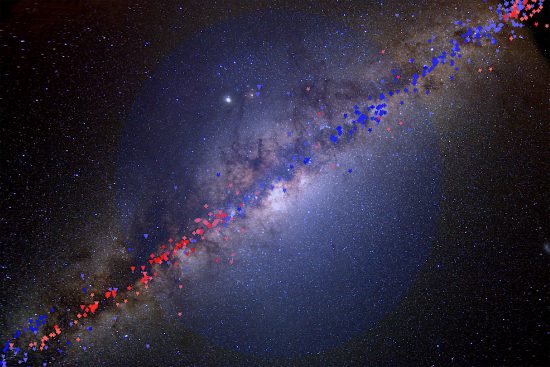
Dec 16, 2019
According to a recent press release, astrophysicists from MIT suggest that gamma rays at the center of the Milky Way could be due to dark matter interactions with normal, or luminous, matter.
There is a “mysterious” surplus of gamma rays in the galactic core. Gamma rays are the most energetic waves in the electromagnetic spectrum. Consensus theories state that they are created from the hottest, most extreme objects in the Universe, such as supernovae and pulsars. Gamma rays are found throughout the Milky Way, but the concentrated glow from the galaxy’s core, known as the galactic center excess, is difficult for physicists to explain.
The Gamma-Ray Large Area Space Telescope (now known as PAMELA) analyzes the properties of high energy signals from deep space. Such signals are thought possible because particles not included in the Standard Model might be interacting, producing bright gamma ray sources. Previous Picture of the Day articles take issue with the theory of dark matter, in general, and with the idea that “dark matter particles” can collide and annihilate each other.
The center of the galaxy is so dense that astronomers believe dark matter particles are “packed in” tight, thereby increasing the chance that they will destroy each other. One of the components of dark matter theory is that they act like antiparticles, as well as particles. In other words, if two dark matter entities meet, they appear to one another like antimatter and convert their individual masses into energy. Conversely, there might be “anti-dark matter particles” that react with dark matter in the same way that antimatter is said to react with normal matter. Such excursions go far beyond conservative ideas about galactic evolution.
Cosmologists think there is not enough gravity in the Universe to account for galaxy formation, or for those galaxies to assemble into clusters, so dark matter theory was invented. Another problem is that galaxy clusters should have slowed down their rapid theoretical recessional velocities over the last few billion years. It is not the point of this paper to take issue with the problems inherent in the calculation of those velocities, however they have been addressed many times elsewhere.
Electric Universe proponents share a different view regarding the nature of the cosmos. Astrophysicist Hannes Alfvén came up with an “electric galaxy” theory as early as 1981. Alfvén observed that galaxies resemble homopolar motors. A homopolar motor is driven by a radial electric current in a circular metal disk. The metal disk is placed between the poles of a magnet whereupon the interacting magnetic fields cause it to spin at a rate proportional to the input current.
Galactic discs behave like the conductive disks in said motor. Birkeland currents flow within galactic disks, powering their stars. Galaxies are, in turn, powered by intergalactic Birkeland currents that are detectable by the radio signals they induce. Since Birkeland currents are drawn toward each other in a 1/√r relationship, dark matter can be dismissed when electric currents flowing through dusty plasma are recognized as an attractive force.
Gamma ray (and X-ray) observations of the galactic core also reveal a plasma torus structure there known as a “plasmoid.” High frequency radiation from the plasmoid is similar to that from electrically excited stars. A strong electromagnetic field in the plasmoid accelerates particles to high speed, causing them to spiral in the resulting magnetic field and emit X-rays and gamma rays.
A plasmoid generates the glow from the galaxy.
Stephen Smith
The Thunderbolts Picture of the Day is generously supported by the Mainwaring Archive Foundation.












